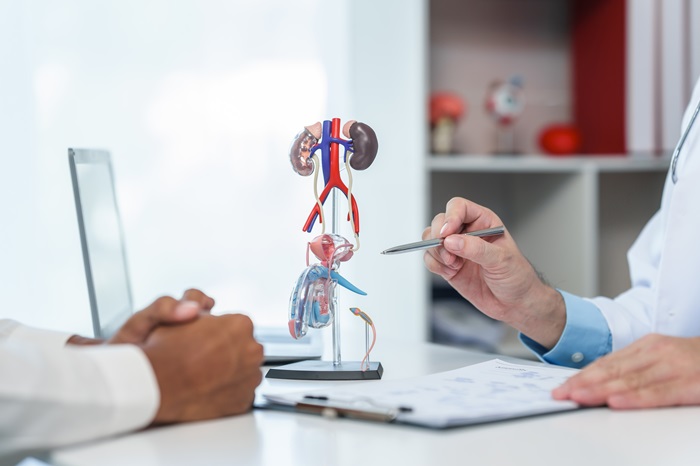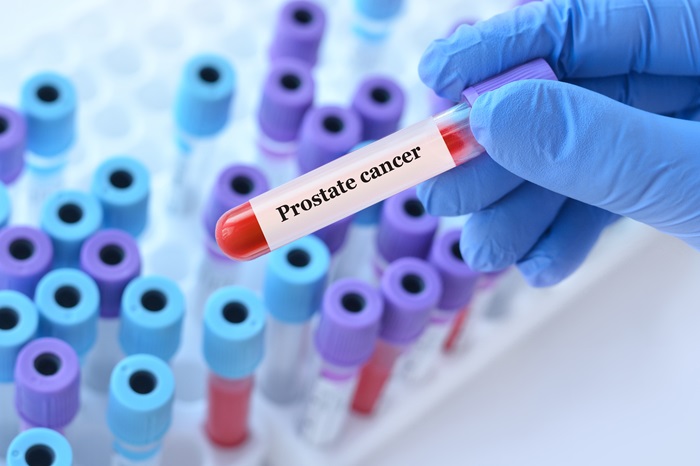Introduction
Prostate cancer is among the most prevalent male cancer. It develops in the prostate (a small gland in the male reproductive system). The prostate is responsible for secreting seminal fluid, which nourishes and transports sperm during ejaculation. Understanding prostate cancer symptoms, causes, and types is crucial for early detection and effective treatment. This blog will explore various aspects of prostate cancer, from its definition to prevention strategies.
What is Prostate Cancer?

It occurs when prostate cells begin to grow uncontrollably. These cells can form tumours and, in some cases, spread to other body parts. The prostate gland lies beneath the bladder & anterior to the rectum, surrounding the urethra. As men grow old, the risk of getting prostate cancer increases, making it a significant health concern for older males.
What are the Types of Prostate Cancer?
While most prostate cancers are adenocarcinomas, there are several types of prostate cancer:
- Acinar Adenocarcinoma: The most common type, accounting for nearly 95% of prostate cancers.
- Ductal Adenocarcinoma: A more aggressive form that develops in the cells lining the prostate ducts.
- Transitional Cell (or Urothelial) Cancer: Rare cancer that begins in the cells lining the urethra.
- Squamous Cell Cancer: A sporadic and aggressive form of prostate cancer.
- Small Cell Prostate Cancer: A rare, aggressive neuroendocrine cancer that often spreads quickly.
- Sarcomas: Sporadic cancers that develop in the soft tissues of the prostate.
What are the Common Symptoms Associated with Prostate Cancer?
In the initial stages, prostate cancer often doesn’t cause noticeable symptoms. As the disease progresses, men may experience:
- Difficulty urinating or a weak urine stream
- Increased frequency of urination, especially at night
- Blood in urine or semen
- Erectile dysfunction
- Pain or discomfort in the pelvic area
- Bone pain, common in the lower back, hips, or chest
- Unexplained weight loss or fatigue
What Causes Prostate Cancer?
The exact reason for prostate cancer is not fully understood. However, several factors contribute to its development. Here are some common prostate cancer causes:
- Genetic Mutations: Changes in specific genes, such as BRCA1 & BRCA2, can elevate the risk of prostate cancer.
- Hormonal Factors: Androgens, particularly testosterone, play a role in prostate cancer growth.
- Cellular Changes: Normal prostate cells may undergo changes that lead to precancerous conditions or cancer.
- Environmental Factors: Exposure to chemicals or radiation may increase the risk.
- Lifestyle Factors: Diet, obesity, and lack of exercise may contribute to prostate cancer development.
What are the Common Risk Factors Associated with Prostate Cancer?
Several factors can raise a man’s risk of developing prostate cancer. The following are some common prostate cancer risk factors:
- Age: The risk increases after 50 years of age.
- Family History: Men with a father or brother having a history of prostate cancer are at higher risk.
- Genetic Factors: Inherited gene mutations (BRCA1 and BRCA2) can increase risk.
- Diet: A diet high in red meat and high-fat dairy products may increase risk.
- Obesity: Being overweight or obese may enhance the risk of aggressive prostate cancer.
- Geographic Location: Prostate tumours are more common in North America, Europe, and Australia.
How is Prostate Cancer Diagnosed?

Diagnosing prostate cancer involves several steps and tests:
Screening Tests for Prostate Cancer:
- Prostate-Specific Antigen (PSA) test: A blood test measuring PSA levels. Elevated PSA levels may indicate prostate cancer.
- Digital Rectal Exam (DRE): A physical examination where a doctor examines the prostate for abnormalities.
Diagnostic Procedures for Prostate Cancer:
- Prostate Biopsy: If screening tests suggest cancer, a biopsy is performed to confirm the diagnosis.
- Imaging Tests: MRI, CT scans, or bone scans may be used to determine if cancer has spread.
- Genomic Testing: In some cases, genetic tests may be performed on the cancer cells to guide treatment decisions.
What are the Grades and Stages of Prostate Tumour?
Grading Prostate Cancer:
The Gleason score grades prostate cancer, ranging from 6 to 10. A higher score indicates more aggressive cancer.
Staging Prostate Cancer:
The TNM System is used to Stage Prostate Cancer:
- T: Extent of the primary tumour
- N: Spread to nearby lymph nodes
- M: Presence of distant metastasis
Stages range from I (early-stage, confined to the prostate) to IV (advanced, spread to other parts of the body). We will discuss the TNM system in detail below.
Stages of Prostate Cancer
Doctors generally use the TNM (Tumour, Node, and Metastasis) system to determine the stage of prostate cancer. It has three main components:
- T (tumour): It describes the tumour’s size, location, and how deep it has grown into the tissue.
- N (node): It indicates whether cancer cells have spread to the nearby lymph nodes or the channels connecting the lymph nodes.
- M (metastasis): It determines whether the cancer cells have spread to other organs or tissues.
According to the TNM system, prostate cancer has four stages, ranging from 1 to 4. Here are the four stages of prostate cancer:
- Stage 1 prostate cancer means that the cancer cells are limited to the prostate and haven’t spread to other parts of the body.
- Stage 2 prostate cancer means the cancer cells are limited to the prostate but have a greater risk of spreading to lymph nodes or other parts of the body.
- Stage 3 prostate cancer means that the cancer is locally advanced, which means it has spread outside the prostate and may be in the seminal vesicles (reproductive glands that produce the fluid in semen).
- Stage 4 prostate cancer means the cancer has spread to lymph nodes, organs, or tissues.
Management and Treatment
Treatment approaches for prostate cancer depend on various factors, including the cancer’s stage, grade, and the patient’s overall health and preferences. Common prostate cancer treatments include:
- Active Surveillance: Regular monitoring without immediate treatment is performed for low-risk, slow-growing cancers.
- Surgery: Radical prostatectomy procedure to remove the entire prostate gland.
- Radiation Therapy: Brachytherapy or external beam radiation to kill cancer cells
- Hormone Therapy: Reducing androgen levels or blocking their effects to slow cancer growth.
- Chemotherapy: Used for advanced or hormone-resistant prostate cancer
- Immunotherapy: Activating the person’s immune system to fight cancer cells.
- Targeted Therapy: Using specific drugs that target specific genetic changes in cancer cells
- Cryotherapy: Freezing cancer cells to destroy them.
- High-intensity focused ultrasound (HIFU): Using sound waves to destroy cancer cells.
What are the Different Side Effects of Prostate Cancer Treatment?
Treatment side effects can vary and depend on the type of treatment:
- Surgery: Urinary incontinence, erectile dysfunction
- Radiation Therapy: Urinary problems, bowel issues, erectile dysfunction
- Hormone Therapy: Hot flashes, loss of libido, weight gain, mood changes
- Chemotherapy: Fatigue, nausea, hair loss, increased risk of infections
It’s important to discuss potential side effects with your doctor when considering treatment options.
Prevention
While there’s no assured way to prevent prostate cancer, certain lifestyle changes may help reduce risk:
- Maintain a healthy diet enriched in fruits, vegetables, and whole grains
- Exercise regularly
- Maintain a healthy weight
- Quit smoking
- Limit alcohol consumption
- Consider discussing the use of 5-alpha reductase inhibitors with your doctor.
Regular check-ups and screenings, especially for men at higher risk, can help detect prostate cancer early when it’s most treatable.
When to see a doctor
If you have signs or symptoms such as difficulty in peeing, peeing more frequently, pain while peeing or intercourse, or blood in your pee or semen, visit a doctor immediately.
Conclusion
Prostate tumour is a complex disease that affects many men worldwide. Understanding its symptoms, causes, and types is crucial for early detection and effective management. While the diagnosis of having prostate cancer can be daunting, advances in treatment options have significantly improved outcomes for many patients. By staying informed, maintaining a healthy lifestyle, and working closely with doctors, men can take proactive steps to manage their prostate health and overall well-being.
Frequently Ask Questions
Can prostate cancer be 100% cured?
While prostate cancer can be effectively treated, especially when caught early, it’s difficult to guarantee a 100% cure. Many men with prostate cancer can achieve long-term remission or live with the disease for many years without it progressing. Treatment success depends on numerous factors, including the cancer’s stage at diagnosis, its aggressiveness, and the patient’s overall health. Regular post-treatment follow-ups are essential to monitor for any recurrence.
How long can a man live with prostate cancer?
The life expectancy for men with prostate cancer varies greatly. It depends on factors such as the stage of cancer at diagnosis, its aggressiveness, and the patient’s overall health and age. Many men, especially those with early-stage or less aggressive forms of prostate cancer, can live for many years or even decades after diagnosis.
Is prostate cancer fatal?
Prostate cancer can be life-threatening, mainly if it’s aggressive or diagnosed at an advanced stage. However, many prostate cancers are slow-growing and may not pose an immediate threat to life. Many males with prostate cancer die from other causes before the cancer becomes life-threatening. Regular screenings and check-ups, especially for men at higher risk, can help catch the disease early when it’s most treatable.
How treatable is prostate cancer?
Prostate cancer is generally considered highly treatable, especially when detected early. Treatment approaches have enhanced significantly over the years, offering patients better outcomes. The treatability depends on factors such as:
- Stage of cancer at diagnosis
- Aggressiveness of the cancer (Gleason score)
- Patient’s age and overall health
- Chosen treatment method

